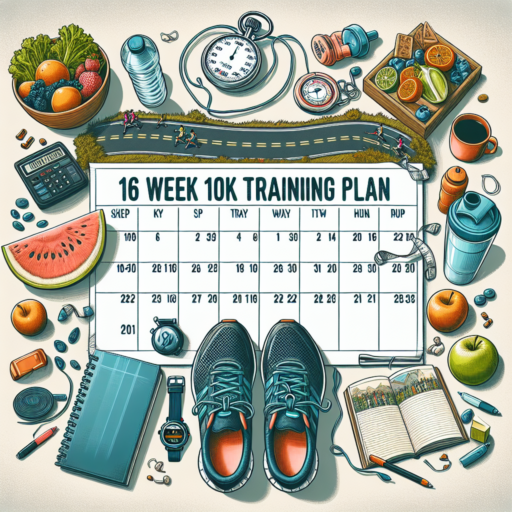How to structure a 10K training plan?
Developing a 10K training plan requires a balanced approach that caters to both beginners and seasoned runners seeking to improve. The key lies in building endurance, speed, and recovery in a structured manner. This guide outlines the essential components of a successful 10K training plan.
Establish a Base Level of Fitness
Before diving into a specific 10K plan, it’s crucial to assess and establish your base level of fitness. If you’re new to running, begin with regular, shorter runs to build up a foundation of endurance. For those with more experience, ensure that your current running routine can seamlessly transition into the more intense demands of 10K training. Focus on a mix of easy runs, maintaining a pace where conversation is possible, to solidify this base.
Incorporate Interval and Tempo Runs
Interval and tempo runs are essential for improving your 10K performance. Interval runs, which involve short bursts of high-intensity running followed by rest or easy running, enhance your speed and aerobic capacity. Tempo runs, sustained efforts at a challenging but manageable pace, improve your lactate threshold, or the intensity at which fatigue begins to overtake your ability to maintain speed. Including these workouts once a week can significantly boost your stamina and running efficiency.
Rest and Recovery
Equally important in your 10K training plan is the inclusion of adequate rest and recovery. This does not necessarily mean complete rest days—although those are important—but also includes easy days where your running is significantly more relaxed and shorter in duration. Remember, improvement happens during recovery, as it gives your body the chance to rebuild stronger. Incorporate stretching, cross-training, and adequate sleep into your recovery strategy to reduce the risk of injury and improve overall performance.
How long should a 10K training plan be?
Deciding the optimal duration for a 10K training plan is crucial for both newcomers and seasoned runners aiming to crush their personal records. Typically, a well-rounded 10K training plan spans from 8 to 12 weeks. This timeframe allows runners to gradually increase their mileage, building endurance while minimizing the risk of injury. It’s a balanced approach that factors in enough time for adaptation, recovery, and performance improvement.
For beginners, a 12-week training plan is often recommended. This schedule provides ample time to build a solid running base without overwhelming the body. During this period, the focus should be on slowly increasing the distance while incorporating rest days and cross-training to support overall fitness and prevent burnout. On the other hand, more experienced runners might opt for an 8-week schedule, focusing on improving speed, endurance, and race strategy.
Regardless of the chosen duration, incorporating variety in the training is key. This includes mixing different types of workouts such as long runs, speed work, easy days, and cross-training. Such a diversified approach not only keeps the training engaging but also enhances different aspects of running performance. Making time for proper warm-up before runs and cool-down sessions afterward is equally important to ensure safety and good results.
Can I train for a 10K in a year?
Absolutely, preparing for a 10K run within a year is not just feasible, it’s a goal well within reach for many aspiring runners. This timeframe allows for a gradual buildup of distance and stamina, significantly reducing the risk of injuries that often accompany more aggressive training schedules. The key lies in developing a consistent and balanced training regimen that incrementally increases your running capacity.
Understanding Your Starting Point
Before diving into a 10K training plan, it’s crucial to assess your current level of fitness. If you’re starting from scratch, you’ll need to focus initially on building a base level of running endurance. This may involve starting with short distances and incorporating walking intervals. As your fitness improves, these intervals will decrease, and your running time will increase, preparing your body for more prolonged periods of running.
Incremental Training and Rest
An effective 10K training plan will include a mix of running workouts, cross-training, and rest days to ensure a well-rounded approach. Starting with shorter runs, you will gradually increase your mileage each week. It’s essential not to overlook the importance of rest days; they’re crucial for recovery and preventing overuse injuries. Additionally, incorporating strength training and flexibility exercises can enhance your running performance and further reduce the risk of injury.
Remember, consistency is more important than intensity when it comes to training for a 10K, especially if you have a whole year to prepare. By steadily increasing your running distance and integrating variety in your workouts, you will not only improve your physical stamina but also keep your motivation high throughout the training process.
No se han encontrado productos.
How can I run a faster 10K plan?
To improve your 10K running speed, incorporating varied training routines is essential. Focusing on not just distance, but also speed and agility can make a significant difference in your times. Here are some strategies to help you develop a faster 10K plan:
Integrate Interval Training
Interval training is key to boosting your speed. This involves short bursts of high-intensity running followed by periods of low intensity or rest. Incorporating this into your weekly training plan can improve your aerobic capacity, allowing you to maintain a faster pace for longer during your 10K race.
Incorporate Strength Training
Strength training, especially focusing on your lower body and core, can greatly enhance your running efficiency. Exercises such as squats, lunges, and planks improve muscle endurance and power, which are crucial for increasing your speed. Including two strength training sessions per week can lead to noticeable improvements in your running performance.




